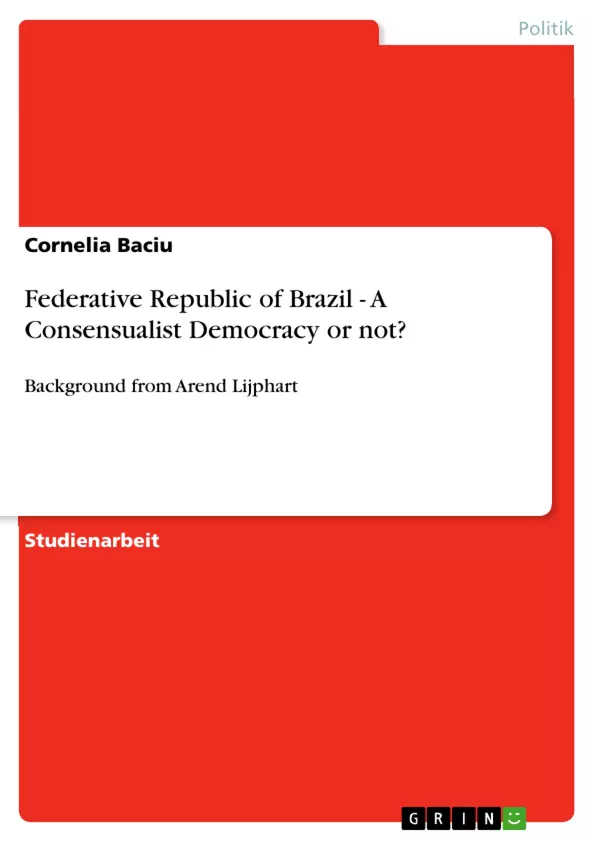I would like in this Hausarbeit to demonstrate, with a background from Arend Lijphart`s arguments, stated in the book „Patterns of Democracy. Government Forms and Performance in Thirty-Six Countries“, if Brazil it is or not a consensualist democracy. Arend Lijphart considers that each system of government can receive one of the next attributes: majoritarian or consensualist. He gives ten opposite criteria, on two dimensions, on which can extend the two types of democracy (majoriatrian and consensualist). I intend to make a logical digest, searching each of this criterion on Brazil`s case. At the end, after considering all ten criteria, I will be able to say if Federative Republic of Brazil it`s a consensualist democracy or not.
Inhaltsverzeichnis
- Federative Republic of Brazil. A Consensualist Democracy or not?
- Executive-parties dimension
- The first difference refers to the structure of executive branch.
- The executive branch of the Brazilian government is the cabinet of Brazil.
Zielsetzung und Themenschwerpunkte
Die vorliegende Hausarbeit analysiert, ob die Federative Republik Brasilien eine konsensuelle Demokratie ist oder nicht. Die Arbeit stützt sich auf die Argumente von Arend Lijphart aus seinem Buch "Patterns of Democracy. Government Forms and Performance in Thirty-Six Countries".
- Untersuchung der Charakteristika eines konsensuellen Demokratiemodells nach Lijphart
- Analyse der brasilianischen politischen Realität im Hinblick auf diese Kriterien
- Einteilung Brasiliens in das majoritäre oder konsensuelle Demokratiemodell basierend auf den zehn Kriterien von Lijphart
- Beurteilung der brasilianischen Regierungsform im Kontext der Theorien von Lijphart
- Diskussion der Bedeutung des konsensuellen Demokratiemodells für die brasilianische Politik
Zusammenfassung der Kapitel
Der erste Abschnitt der Arbeit erläutert das Konzept der konsensuellen Demokratie nach Arend Lijphart und stellt die zehn Kriterien vor, die er zur Unterscheidung zwischen majoritären und konsensuellen Demokratien verwendet. Im zweiten Abschnitt wird die Struktur der Exekutive in Brasilien im Detail analysiert und anhand der Kriterien von Lijphart beurteilt, ob sie eher majoritär oder konsensuell geprägt ist.
Schlüsselwörter
Konsensuelle Demokratie, Majoritäre Demokratie, Arend Lijphart, Brasilien, Exekutive, Regierung, Politik, Verfassungsrecht, Institutionen, Vergleichende Politikwissenschaft.
- Quote paper
- Cornelia Baciu (Author), 2009, Federative Republic of Brazil - A Consensualist Democracy or not?, Munich, GRIN Verlag, https://www.grin.com/document/148654



